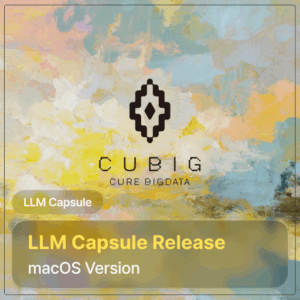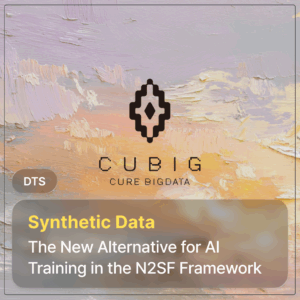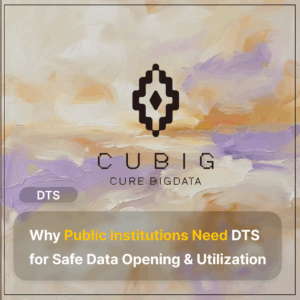Why Public Institutions Need DTS for Safe Data Opening & Utilization(feat. 2025 Public Data Provision & Data-Driven Administration Evaluation Guidelines)
Table of Contents
Hello, this is CUBIG — a company dedicated to unlocking data that has long been inaccessible. 😎
In 2026, the standards for public-sector data utilization are changing.
This year’s Public Data Provision & Data-Driven Administration Evaluation Guidelines have added “Pseudonymized Data Provision & Synthetic Data Sharing” as a bonus scoring item.
This means public institutions are no longer evaluated solely on how much data they disclose. The focus is shifting toward how safely and effectively the data can be transformed and reused.
As a result, synthetic data is becoming an increasingly important tool for public-sector data operations.
Why Is Public-Sector Data So Hard to Use? 🤔
Public institutions handle highly sensitive information collected through administrative processes:
addresses, contact details, family data, health information, welfare records, consultation logs — the list goes on.
These datasets hold tremendous value, but they are extremely difficult to analyze or share, especially outside the organization.
Traditional synthetic data technologies rely on directly learning from the original data, which may leave subtle traces of the source. In the event of a model attack or malfunction, it becomes difficult to rule out the possibility of exposure.
DTS fundamentally avoids this risk.
It is built on a non-access architecture, meaning the model never sees the original data in the first place. Combined with Differential Privacy (DP), DTS satisfies the strict security requirements of public institutions.
“The Data Is Secure… but We Can’t Analyze It” 📉
A Common Challenge in Public Institutions
This phrase is something we hear often in the public sector.
During conventional de-identification, important information is deleted. This increases missing values, worsens bias, removes rare cases, and breaks structural relationships — ultimately making the dataset unsuitable for analysis or AI development.
DTS takes a different approach.
It is not simply a tool for removing personal information.
During synthetic generation, DTS automatically performs:
• Missing-value rebuilding
• Rare-class reconstruction
• Bias mitigation
• Attribute regeneration
The result is AI-ready synthetic data that is often more usable than the original data for analysis, modeling, and research.

How Can Public Institutions Reduce Long Review Procedures? ⏱️
Data sharing in the public sector typically requires:
• Security review
• Re-identification risk assessment
• Legal review
• Multi-step internal approvals
These processes often take months.
DTS shortens this cycle.
When synthetic data is generated, DTS automatically produces a SynData Validation Report, which includes:
• Statistical similarity metrics
• AI model performance comparison
• Re-identification risk score
• Structural suitability checks
Even institutions without dedicated data specialists can make quick, informed decisions about data utilization.
Public-Sector Data Comes in Many Forms 📊📄📷📈
DTS Handles All of Them
Government data isn’t limited to structured tables.
It includes:
• Unstructured complaints and documents (text)
• Administrative statistics (tables)
• CCTV footage and inspection images (images)
• City-scale sensor streams (time-series)
Most synthetic data tools only support one of these data types, requiring several separate systems.
DTS supports all major data formats within a single framework — tables, text, images, and time-series.
This makes data operations more efficient and reduces the need for multiple systems.
Synthetic Data in “No-Outbound” Environments 🔒
A Practical Option for Public Institutions
Most public institutions operate in network-segmented environments where external data transfer is restricted.
Traditional synthetic data solutions often require:
- Uploading original data to an external server, or
- Importing an external model into the secured environment.
Both are difficult — and sometimes impossible — in the public sector.
DTS solves this problem.
Its non-access architecture allows synthetic data to be generated within internal infrastructure, without moving original data outside.
Institutions handling highly sensitive data can safely create and share synthetic data internally and even collaborate with other organizations.
A Clear Signal: Synthetic Data Is Now Recognized in Public Data Evaluation 📘
The 2025 evaluation guidelines explicitly include “Pseudonymized Data Provision & Synthetic Data Sharing” as a bonus scoring item.
This indicates an institutional shift toward recognizing safe data transformation and utilization, not just raw disclosure.
As institutions balance data security with scoring performance, synthetic data provides an alternative that satisfies both needs.

DTS supports public institutions by addressing the recurring challenges they face:
• Limitations due to sensitive information
• Low data quality after de-identification
• Long and complex approval procedures
• Multiple data formats
• Network isolation and no-export environments
While every institution has different priorities, DTS is a practical option for those considering synthetic data for safer, faster, and more efficient public-sector data operations.
If you would like tailored guidance, feasibility assessment, or a DTS demo for your environment, we’re here to help.

CUBIG's Service Line
Recommended Posts
-

Launching LLM Capsule for macOS: using generative AI at work while staying compliant with privacy regulations
-

Synthetic data AI training: a new path for public institutions in the N2SF era
-

Why Public Institutions Need DTS for Safe Data Opening & Utilization(feat. 2025 Public Data Provision & Data-Driven Administration Evaluation Guidelines)






